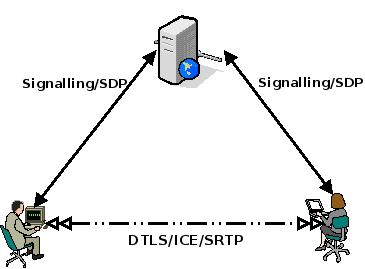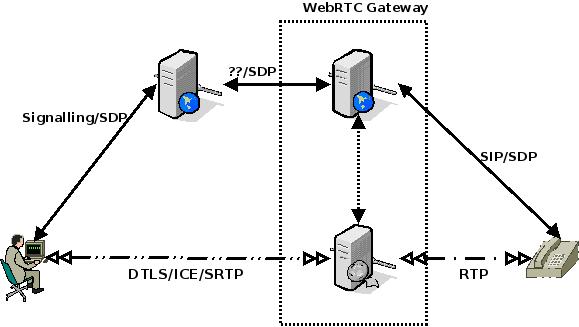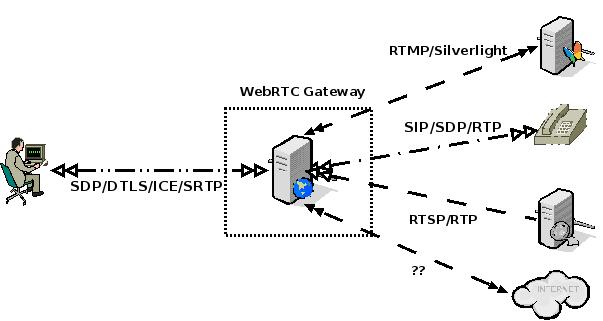[转]What is a WebRTC Gateway anyway? (Lorenzo Miniero)
[转]What is a WebRTC Gateway anyway? (Lorenzo Miniero)
https://webrtchacks.com/webrtc-gw/
As I mentioned in my ‘WebRTC meets telecom’ article a couple of weeks ago, at Quobis we’re currently involved in 30+ WebRTC field trials/POCs which involve in one way or another a telco network. In most cases service providers are trying to provide WebRTC-based access to their existing/legacy infrastructure and services (fortunately, in some cases it’s not limited to do only that). To achieve all this, one of the pieces they need to deploy is a WebRTC Gateway. But, what is a WebRTC Gateway anyway? A year ago I had the chance to provide a first answer during the Kamailio World Conference 2013 (see my presentation WebRTC and VoIP: bridging the gap) but, since Lorenzo Miniero has recently released an open source, modular and general purpose WebRTC gateway called Janus, I thought it would be great to get him to share his experience here.
I’ve known Lorenzo for some years now. He is the co-founder of a small but great startup called Meetecho. Meetecho is an academic spinoff of the University of Napoli Federico II, where Lorenzo is currently also a Ph.D student. He has been involved in real-time multimedia applications over the Internet for years, especially from a standardisation point of view. Within the IETF, in particular, he especially worked in XCON on Centralized Conferencing and MEDIACTRL on the interactions between Application Servers and Media Servers. He is currently working on WebRTC-related applications, in particular on conferencing and large scale streaming as part of his Ph.D, focusing on the interaction with legacy infrastructures — here it is where WebRTC gateways play an interesting role. As part of the Meetecho team he also provides remote participation services on a regular basis to all IETF meetings. Most recently, he also spent some time reviewing Simon P. and Salvatore’s L. new WebRTC book.
{“intro-by” : “victor“}

Lorenzo Miniero
What is a WebRTC Gateway anyway? (by Lorenzo Miniero)
Since day one, WebRTC has been seen as a great opportunity by two different worlds: those who envisaged the chance to create innovative and new applications based on a new paradigm, and those who basically just envisioned a new client to legacy services and applications. Whether you belong to the former or the latter (or anywhere in between, as me), good chances are that, sooner or later, you eventually faced the need for some kind of component to be placed between two or more WebRTC peers, thus going beyond (or simply breaking) the end-to-end approach WebRTC is based upon. I, for one, did, and have devoted my WebRTC-related efforts in that direction since WebRTC first saw the light.
A different kind of peer
As you probably already know (and if you don’t, head here and do your homework!), WebRTC has been conceived as a peer-to-peer solution: that is, while signalling goes through a web server/application, the media flow is peer-to-peer.

Figure 1: WebRTC native peer-to-peer communication
I won’t go into the details of how this paradigm may change, especially considering this has been the subject of a previous blog post. What’s important to point out is that, even in a simple peer-to-peer scenario, one of the two involved parties (or maybe even both) doesn’t need to be a browser, but may very well be an application. The reasons for having such an application may be several: it may be acting as an MCU, a media recorder, an IVR application, a bridge towards a more or less different technology (e.g., SIP, RTMP, or any legacy streaming platform) or something else. Such an application, which should implement most, if not all, the WebRTC protocols and technologies, is what is usually called a WebRTC Gateway: one side talks WebRTC, while the other still WebRTC or something entirely different (e.g., translating signalling protocols and/or transcoding media packets).

Figure 2: One of the peers as a logically decomposed WebRTC gateway (SIP example)
Gateways? Why??
As anticipated, there are several reasons why a gateway can be useful. Technically speaking, MCUs and server-side stacks can be seen as gateways as well, which means that, even when you don’t step outside the WebRTC world and just want to extend the one-to-one/full-mesh paradigm among peers, having such a component can definitely help according to the scenario you want to achieve.
Nevertheless, the main motivation comes from the tons of existing and so called legacy infrastructures out there, that may benefit from a WebRTC-enabled kind of access. In fact, one would assume that the re-use of existing protocols like SDP, RTP and others in WebRTC would make this trivial. Unfortunately, most of the times that is not the case. In fact, if for instance we refer to existing SIP infrastructures, even by making use of SIP as a signalling protocol in WebRTC there are too many differences between the standards WebRTC endpoints implement and those available in the currently widely available deployments.
Just to make a simple example, most legacy components don’t support media encryption, and when they do they usually only support SDES. On the other end, for security reasons WebRTC mandates the use of DTLS as the only way to establish a secure media connection, a mechanism that has been around for a while but that has seen little or no deployment in the existing communication frameworks so far. The same incompatibilities between the two worlds emerge in other aspects as well, like the extensive use WebRTC endpoints make of ICE for NAT traversal, RTCP feedback messages for managing the status of a connection or RTP/RTCP muxing, whereas existing infrastructures usually rely on simpler approaches like Hosted Nat Traversal (HNT) in SBCs, separate even/odd ports for RTP and RTCP, and more or less basic RFC3550 RTCP statistics and messages. Things get even wilder when we think of the additional stuff, mandatory or not, that is being added to WebRTC right now, as BUNDLE, Trickle ICE, new codecs the existing media servers will most likely not support and so on, not to mention Data Channels and WebSockets and the way they could be used in a WebRTC environment to transport protocols like BFCP or MSRP, that SBCs or other legacy components would usually expect on TCP and/or UDP and negotiated the old fashioned way.
Ok, we need a gateway… what now?
Luckily for you (and for us all!), several people have worked on gateways since the first WebRTC browsers have been made available. Even just to focus on open source efforts alone, a lot of work has been done on platforms like Asterisk or Kamailio to make the interaction with existing SIP infrastructures easier, and new components like Doubango, Kurento, Licode or the Jitsi stack have been released in the latest months. Each application usually addresses different requirements, depending on whether you just need a WebRTC-to-SIP gateway, a conferencing MCU, a WebRTC-compliant streaming server, a more generic stack/media server and so on.
Since I’ve recently worked on an open source WebRTC gateway implementation called Janus myself, and considering its more general purpose approach to gatewaying, I’ll try and guide you through the common requirements and challenges such a WebRTC-driven project can face you with.
Where to start?
When it comes to gateways, the harder step is always the first one. Where should you start? The easiest way is starting from addressing the functional requirements, that usually are:
- architectural, as in “should the gateway be monolithic, or somehow decomposed between signalling and media plane”?;
- protocols, as you’ll need to be able to talk WebRTC and probably something else too, if you’re going to translate to a more or less different technology;
- media management, depending on whether you’re only going to relay media around or handle it directly (e.g., transcoding, mixing, recording, etc.);
- signalling, that is how you’re going to setup and manage media sessions on either side;
- putting this all together, as, especially in WebRTC, all current implementations have expectations on how the involved technologies should behave, and may not work if they’re failed.
The first point in particular is quite important, as it will obviously impact the way the gateway is subsequently going to be designed and implemented. In fact, while a monolithic approach (where signalling and media planes are handled together) might be easier to design, a decomposed gateway (with signalling and media planes handled separately, and the two interacting somehow) would allow for a separate management of scalability concerns. There is a middle ground, if for instance one relies on a more hybrid modular architecture. That said, all of them have pros and cons, and if properly designed each of them can be scaled as needed.
Apart from that, at least from a superficial point of view there’s nothing in the requirements that is quite different from a WebRTC-compliant endpoint in general. Of course, there are differences to take into account: for one, a gateway is most likely going to handle many more sessions that a single endpoint; besides, no media needs to be played locally, which makes things easier on one side, but presents different complications when it comes to what must happen to the media themselves. The following paragraphs try to go a bit deeper in the genesis of a gateway.
Protocols
The first thing you need to ask when choosing or implementing a WebRTC implementation is: can I avoid re-inventing the wheel? This is a very common question we ask ourselves everyday in several different contexts. Yet, it is even more important when talking about WebRTC, as it does partly re-use existing technologies and protocols, even if “on steroids” as I explained before.
The answer luckily is, at least in part, “mostly“. You may, of course, just take the Chrome stack and start it all from there. As I anticipated, a gateway is, after all, a compliant WebRTC implementation, and so a complete codebase like that can definitely help. For several different reasons, I chose a different approach, that is trying to write something new from scratch. Whatever the programming language, there are several open source libraries you can re-use for the purpose, like openssl (C/C++) or BouncyCastle (Java) for DTLS-SRTP, libnice (C/C++), pjnath (C/C++) or ice4j (Java) for everything related to ICE/STUN/TURN, libsrtp for SRTP and so on. Of course, a stack is only half of the solution: you’ll need to prepare yourself for every situation, e.g., acting as either a DTLS server or client, handle heterogeneous NAT traversal scenarios, and basically be able to interact with all compliant implementations according to the WebRTC specs.
As you may imagine (especially if you read Tim’s rant), things do get a bit harder when it comes to SDP: while there are libraries that allow you to parse, manipulate and generate SDP, the several attributes and features that are needed for WebRTC are quite likely not supported, if not by working on the library a lot. For instance, for Janus I personally chose a relatively lightweight approach: I used Sofia-SDP as a stack for parsing session descriptions, while manually generating them instead of relying on a library for the purpose. Considering the mangling we already all do in JavaScript, until a WebRTC-specific SDP library comes out it looked like the safest course of action. What’s important to point out is that, since the gateway is going to terminate the media connections somehow, the session descriptions must be prepared correctly, and in a way that all compliant implementations must be able to process: which means, be prepared to handle whatever you may receive, as your gateway will need to understand it!
Media
Once you deal with the protocols, you’re left with the media, and again, there are tons of RTP/RTCP libraries you can re-use for the purpose. Once you’re at the media level, you can do what you want: you may want to record the frames a peer is sending, reflect them around for a webinar/conference, transcode them and send them somewhere else, translate RTP and the transported media to and from a different protocol/format, receive some from an external source and send them to a WebRTC endpoint, and so on.

Figure 3: Bridging to different technologies
RTCP in particular, though, needs special care, especially if you’re bridging WebRTC peers through the gateway: in fact, RTCP messages are tightly coupled with the RTP session they’re related to, which means you have to translate the messages going back and forth if you want them to keep their meaning. Considering a gateway is a WebRTC-compliant endpoint, you may also want to take care of the RTCP messages yourself: e.g., retransmit RTP packets when you get a NACK, adapting the bandwidth on reception of a REMB, or keep the WebRTC peer up-to-date on the status of the connection by sending proper feedback. Some more details are available in draft-ietf-straw-b2bua-rtcp which is currently under discussion in the IETF.
Signalling
Last, but not least: what kind of signalling should your gateway employ? WebRTC doesn’t mandate any, which means you’re free to choose the one that fits your requirements. Several implementations rely on SIP, which looks like the natural choice when bridging to existing SIP infrastructures. Others make use of alternative protocols like XMPP/Jingle.
That said, there is not a perfect candidate, as it mostly depends on what you want your gateway to do and what you’re most comfortable with in the first place. If you want it to be as generic as possible, as I did, an alternative approach may be relying on an ad-hoc protocol, e.g., based on JSON or XML, which leaves you the greatest freedom when it comes to design a bridge to other technologies.
Long story short…
As you might have guessed, writing a gateway is not easy. You need to implement all the protocols and use them in a way that allows you to seamlessly interact with all compliant implementations, maybe even fixing what may cause them not to interact with each other as they are, while at the same time taking into account the requirements on the legacy side. You need to tame the SDP beast, be careful of RTCP, and take care of any possible issue that may arise when bridging WebRTC to a different technology. Besides, as you know WebRTC is a moving target, and so what works today in the gateways world may not work tomorrow: which means that keeping updated is of paramount importance.
Anyway, this doesn’t need to scare you. Several good implementations are already available that address different scenarios, so if all you need is an MCU or a way to simply talk to well known legacy technologies, good chances are that one or more of the existing platforms can do it for you. Some implementations, like Janus itself, are even conceived as more or less extensible, which means that, in case no gateway currently supports what you need, you probably don’t need to write a new one from scratch anyway. And besides, as time goes by the so-called legacy implementations will hopefully start aligning with the stuff WebRTC is mandating right now, so that gateways won’t be needed anymore for bridging technologies but only to allow for more complex WebRTC scenarios.
That said, make sure you follow the Server-oriented stack topic on discuss-webrtc for more information!
{“author” : “Lorenzo Miniero“}
Want to keep up on our latest posts? Please click here to subscribe to our mailing list if you have not already. We only email post updates. You can also follow us on twitter at @webrtcHacks for blog updates and news of technical WebRTC topics or our individual feeds @chadwallacehart, @victorpascual and @tsahil.
[转]What is a WebRTC Gateway anyway? (Lorenzo Miniero)的更多相关文章
- 揭开webRTC媒体服务器的神秘面纱——WebRTC媒体服务器&开源项目介绍
揭开webRTC媒体服务器的神秘面纱--WebRTC媒体服务器&开源项目介绍 WebRTC生态系统是非常庞大的.当我第一次尝试理解WebRTC时,网络资源之多让人难以置信.本文针对webRTC ...
- 实时视频直播客户端技术盘点:Native、HTML5、WebRTC、微信小程序
1.前言 2017 年 12 月,微信小程序向开发者开放了实时音视频能力,给业内带来广阔的想象空间.连麦互动视频直播技术在 2016 年直播风口中成为视频直播的标配,然而只有在原生的 APP 上才能保 ...
- Complex Instance Placement
转自: https://specs.openstack.org/openstack/openstack-user-stories/user-stories/proposed/complex-insta ...
- webrtc进阶-信令篇-之三:信令、stun、turn、ice
webRTC支持点对点通讯,但是webRTC仍然需要服务端: . 协调通讯过程中客户端之间需要交换元数据, 如一个客户端找到另一个客户端以及通知另一个客户端开始通讯. . 需要处理NAT(网 ...
- webrtc教程
cdsn博客不支持word文件,所以这里显示不完全.可到本人资源中下载word文档: v0.3:http://download.csdn.net/detail/kl222/6961491 v0.1:h ...
- [WebRTC/JsSIP] AUDIO RTP REPORTS ERROR: [Remote Address Error!]
问题描述: 在使用FreeSWITCH WebRTC 测试时,FS回复 502 Bad Gateway.查看FS日志 [DEBUG] switch_core_media.c:5147 AUDIO R ...
- webrtc doubango linphone
1.doubango官网:http://www.doubango.org/ 2.doubango是一个开源的VOIP基础平台, 并能用于嵌入式和桌面系统的开源框架,该框架使用ANSCI-C编写,具有很 ...
- 真实场景中WebRTC 用到的服务 STUN, TURN 和 signaling
FQ收录转自:WebRTC in the real world: STUN, TURN and signaling WebRTC enables peer to peer communication. ...
- 记一次nginx部署yii2项目时502 bad gateway错误的排查
周六闲来无事,就试着安装和部署下yii2,安装过程没什么问题,但部署到nginx上时遇到了502 bad gatewary问题,折腾了半天才搞定.这个问题是我以前在部署yii2时没有遇到过的,因此记在 ...
随机推荐
- 市面上有没有靠谱的PM2.5检测仪?如何自己动手制作PM2.5检测仪
市面上能买到的11中常见的pm2.5检测仪 网上大佬实测并不是很准,我这里没测过(全买下来有点贵,贫穷限制了我的想象力) 这些检测仪多数是复合式.多功能的空气质量检测仪.具体就不一一介绍了.这篇文章 ...
- maven 在pom文件下配置默认的jdk版本
在pom.xml中加入这段代码就可以了 <!-- 设置默认的jdk --> <profiles> <profile> <id>jdk1.7</id ...
- NumPy学习_00 ndarray的创建
1.使用array()函数创建数组 参数可以为:单层或嵌套列表:嵌套元组或元组列表:元组或列表组成的列表 # 导入numpy库 import numpy as np # 由单层列表创建 a = np. ...
- lower_bound()返回值
lower_bound()函数实现功能就是二分查找,函数lower_bound()在first和last中的前闭后开区间进行二分查找,返回大于或等于val的第一个元素位置.如果所有元素都小于val,则 ...
- HDU - 3533 bfs [kuangbin带你飞]专题二
看了好久的样例才看懂. 题意:有一个人要从(0,0)走到(n,m),图中有k个碉堡,每个碉堡可以向某个固定的方向每隔t秒放一次炮,炮弹不能穿越另一个碉堡,会被阻挡.人在移动的过程中不会被炮弹打到,也就 ...
- 基于 HTML5 Canvas 的交互式地铁线路图
前言 前两天在 echarts 上寻找灵感的时候,看到了很多有关地图类似的例子,地图定位等等,但是好像就是没有地铁线路图,就自己花了一些时间捣鼓出来了这个交互式地铁线路图的 Demo,地铁线路上的点是 ...
- Web开发框架推导
本文欲回答这样一个问题:在 「特定环境 」下,如何规划Web开发框架,使其能满足 「期望 」? 假设我们的「特定环境 」如下: 技术层面 使用Java语言进行开发 通过Maven构建 基于Spring ...
- JDBC各种数据库连接方式
1)连接Oracle 8/8i/9i/10g/11g(thin模式) Class.forName("oracle.JDBC.driver.OracleDriver").newIns ...
- “大话架构”阿里架构师分享的Java程序员需要突破的技术要点
一.源码分析 源码分析是一种临界知识,掌握了这种临界知识,能不变应万变,源码分析对于很多人来说很枯燥,生涩难懂. 源码阅读,我觉得最核心有三点:技术基础+强烈的求知欲+耐心. 我认为是阅读源码的最核心 ...
- ClientToScreen 和ScreenToClient 用法
ClientToScreen( )是把窗口坐标转换为屏幕坐标 ScreenToClient( )是把屏幕坐标转换为窗口坐标 屏幕坐标是相对于屏幕左上角的,而窗口坐标是相对于窗口用户区左上角的 VC下, ...
